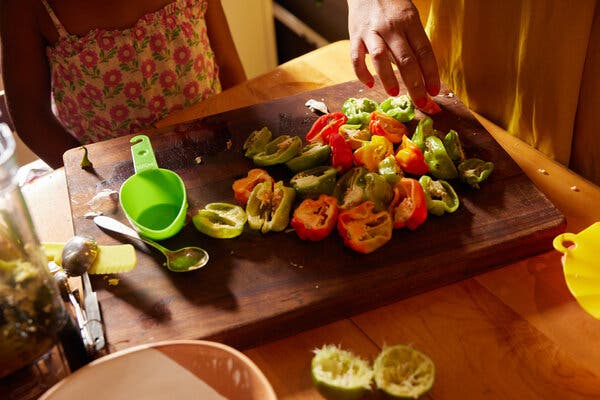

Across the region and the diaspora, the Scotch bonnet lends its distinctive, tart, numbing heat to this hot sauce, offering a taste of the islands and a punch of flavor.
A report by Korsha Wilson for The New York Times.
As a child, the cookbook author Lesley Enston learned maybe the most important lesson about pepper sauce from her uncle Richard in Trinidad and Tobago: Be very careful when handling Scotch bonnet chiles.
“I will always remember coming back to the house in Princes Town and finding him on the couch with his hands up in the air covered in Vaseline,” she writes in her book, “Belly Full: Exploring Caribbean Cuisine Through 11 Fundamental Ingredients and Over 100 Recipes” (Ten Speed Press) released this month.
Recipe: Pepper Sauce
Asked what had happened, he shrugged. He said he’d just finished making a batch of his famous sauce, and the Scotch bonnets’ intense heat had burned his hands.


Uncle Richard’s recipe inspired Ms. Enston’s own, run through with earthy culantro (a fresh herb not to be confused with cilantro), garlic, whole-grain mustard and fresh ginger bolstering the fiery flavor of the essential Scotch bonnets.
Throughout the English- and French-speaking Caribbean, hot sauces — featuring a rotating cast of aromatics, vinegars, herbs, spices, even fruit — fill water bottles and jars in hues of oranges, reds, greens and light pinks. Some are chunky, others thin, but all carry fruit-forward heat and complexity when gently tipped on a plate of rice and peas, tender stewed saltfish or other dishes that benefit from its touch. But the Scotch bonnet, with its distinctive, tart, numbing heat, is always at the heart, adding a Caribbean inflection to dishes.
“They make me think of smoldering coals,” Ms. Enston said, speaking to their smoky, musky nature, adding, “I look at them, and I see my people: colorful, vibrant, spicy.”
Named for their bonnet-like shape, Scotch bonnet chiles are native to South America and crisscrossed the Atlantic Ocean as a result of the spice trade, taking root in Africa and Asia as well as Europe. In the Caribbean, they can be found piled high at grocery stores and markets, ready to be tossed whole into a bubbling pot of stew or cut and blended into pepper or “peppa” sauce.
“We love that pepper so much in the Caribbean,” said Andre Springer, the Barbadian American founder of Shaquanda’s Hot Pepper Sauce, a line of bottled hot sauces bearing the name of Mr. Springer’s drag persona. He often experiments with flavors when creating his pepper sauces, but Scotch bonnet is always included.
“Hot sauces can really be memories and homages to culture and experiences,” Mr. Springer said.

Growing up in Toronto, Ms. Enston’s mother would keep a bottle of her uncle Richard’s pepper sauce, carefully doling out a dollop of the yellow-orange sauce — “never pouring” — onto her plate. A little goes a long way.
“It’s not just the heat, it’s the flavors that come with it,” Ms. Enston said in her kitchen in Bedford-Stuyvesant, Brooklyn, where her daughter cuts the garlic, peels fresh ginger and adds them to the blender. (Ms. Enston takes care of the Scotch bonnets.) After a few seconds of blitzing them until nearly smooth, Ms. Enston jars the sauce for future use.
Across the region and the diaspora, the Scotch bonnet lends its distinctive, tart, numbing heat to this hot sauce, offering a taste of the islands and a punch of flavor. A report by Korsha Wilson for The New York Times. As a child, the cookbook author Lesley Enston learned maybe the most important lesson about pepper






